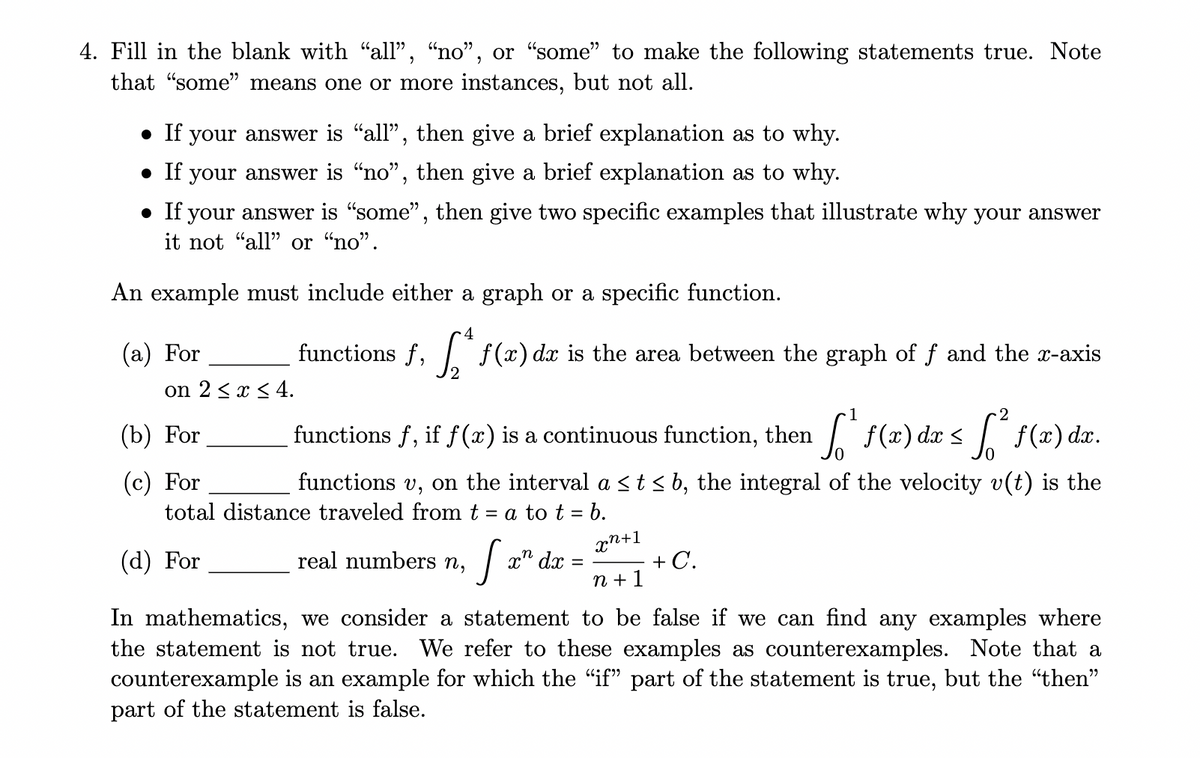4. Fill in the blank with "all", "no", or "some" to make the following statements true. Note that "some" means one or more instances, but not all. • If your answer is "all", then give a brief explanation as to why. • If your answer is "no", then give a brief explanation as to why. • If your answer is "some", then give two specific examples that illustrate why your answer it not "all" or “no". An example must include either a graph or a specific function. (а) For functions f, f(x) dx is the area between the graph of f and the x-axis on 2 < x < 4. (b) For functions f, if f(x) is a continuous function, then f(2) dæ s f(x) dæ. (c) For total distance traveled from t = a to t = b. functions v, on the interval a
4. Fill in the blank with "all", "no", or "some" to make the following statements true. Note that "some" means one or more instances, but not all. • If your answer is "all", then give a brief explanation as to why. • If your answer is "no", then give a brief explanation as to why. • If your answer is "some", then give two specific examples that illustrate why your answer it not "all" or “no". An example must include either a graph or a specific function. (а) For functions f, f(x) dx is the area between the graph of f and the x-axis on 2 < x < 4. (b) For functions f, if f(x) is a continuous function, then f(2) dæ s f(x) dæ. (c) For total distance traveled from t = a to t = b. functions v, on the interval a
Elements Of Modern Algebra
8th Edition
ISBN:9781285463230
Author:Gilbert, Linda, Jimmie
Publisher:Gilbert, Linda, Jimmie
Chapter2: The Integers
Section2.3: Divisibility
Problem 10TFE
Related questions
Question

Transcribed Image Text:4. Fill in the blank with "all", "no", or "some" to make the following statements true. Note
that "some" means one or more instances, but not all.
• If your answer is "all", then give a brief explanation as to why.
• If your answer is "no", then give a brief explanation as to why.
• If your answer is "some", then give two specific examples that illustrate why your answer
it not "all" or "no".
An example must include either a graph or a specific function.
4
(а) For
functions f, f(x) dx is the area between the graph of f and the x-axis
on 2 < x < 4.
1
2
(b) For
functions f, if f(x) is a continuous function, then
f(x) dæ s f (x) dx.
(c) For
total distance traveled from t = a to t = b.
functions v, on the interval a st< b, the integral of the velocity v(t) is the
| x" dx
xn+1
+ C.
n + 1
(d) For
real numbers n,
In mathematics, we consider a statement to be false if we can find any examples where
the statement is not true. We refer to these examples as counterexamples. Note that a
counterexample is an example for which the “if" part of the statement is true, but the "then"
part of the statement is false.
Expert Solution
This question has been solved!
Explore an expertly crafted, step-by-step solution for a thorough understanding of key concepts.
This is a popular solution!
Trending now
This is a popular solution!
Step by step
Solved in 2 steps with 1 images

Recommended textbooks for you

Elements Of Modern Algebra
Algebra
ISBN:
9781285463230
Author:
Gilbert, Linda, Jimmie
Publisher:
Cengage Learning,

Elements Of Modern Algebra
Algebra
ISBN:
9781285463230
Author:
Gilbert, Linda, Jimmie
Publisher:
Cengage Learning,